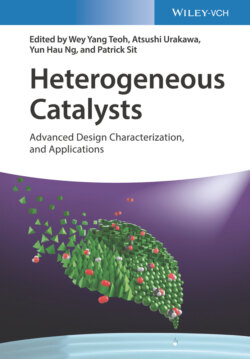Читать книгу Heterogeneous Catalysts - Группа авторов - Страница 50
4.2.2.3 Graphene Derivatives: Doped Graphene and Synthetic Derivatives
ОглавлениеGraphyne and graphdiyne are synthetic derivatives of graphene. They are synthetic flat single atomic layers consisting of carbon hexagons connected by linear carbon chains instead of only carbon hexagons as in graphene. In graphyne structure, the hexagons are bonded by linear acetylenic chains, whereas in graphdiyne the hexagons are bonded by two acetylenic chains (Figure 4.2A–C). Graphdiyne is a new man‐made carbon allotrope prepared from a molecular precursor (hexaethynylbenzene) that possesses uniform 18 C‐hexagonal pores formed by three butadiyne linkages (‐C between the benzene rings), which can provide ideal anchoring sites for SACs with high stability as demonstrated by the results of theoretical calculations and in experiments in hydrogen evolution reaction (HER) [22]. The research about these graphene derivatives as catalyst support is almost unexplored due to the novelty of the material. It is foreseen that these derivatives are more amenable to functionalization with SACs than their parent material graphene. Therefore, a research field remains open for new researchers.
Figure 4.2 Structure of some 2D structures related to graphene: (A) graphene; (B, C) synthetic graphene derivatives (graphyne and graphdiyne); (D) graphitic carbon nitride, based on heptazine unit (a) and triazine unit (b); (E) covalent triazine frameworks (CTFs) with different structures: (a) CTF‐1 with hexagonal packing of pores synthesized by ionothermal trimerization and (b) PCTF‐1 synthesized by phosphorous pentoxide catalyst (P2O5) catalyzed condensation method.
